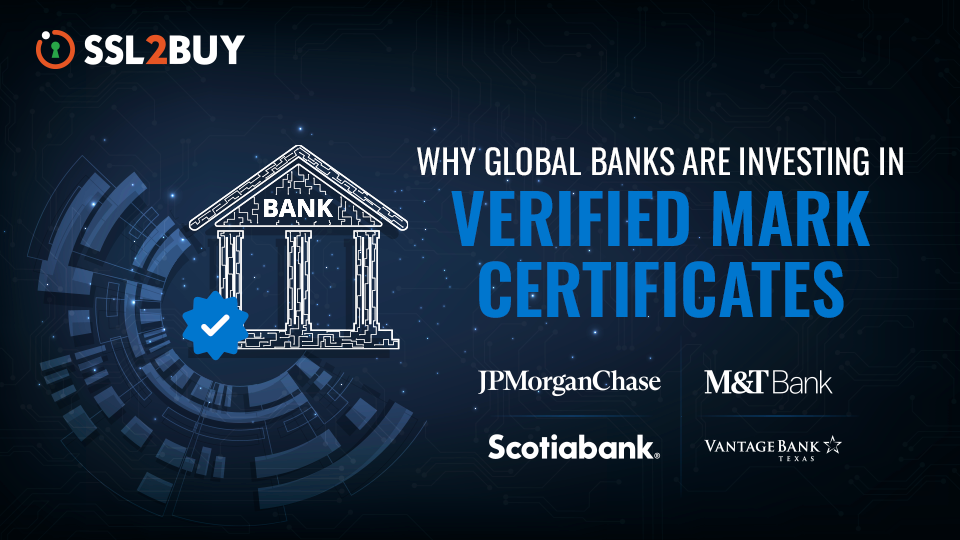Adoption of Verified Mark Certificates Across Banking and Financial Institutions
Every major bank uses email for: account alerts, fraud warnings, OTPs, KYC reminders, loan status, card replacements and rate changes. But that makes banks a prime target for phishing. Today’s phishing emails blend clean design, correct grammar and brand styling, so look-alike domains and spoofed messages slip past busy inbox scans.
The stakes for banks go far beyond reputation. Independent research places the average cost of a data breach at $4.4M, with financial services facing even higher exposure. And those figures only cover direct losses. The secondary effects: lost customers, call-center spikes and regulatory aftercare; a single credible spoof can ripple across quarters.
This is why Verified Mark Certificates (VMCs) are now emerging as the new standard for email trust in banking. A bank’s verified logo in the inbox gives customers instant visual confirmation that the message is authentic.
How VMC Certificates Are a Game-Changer for Banks
Most security protocols work in the background – Encryption, DMARC, SPF, DKIM. Customers never see them, even though they silently keep email secure. A Verified Mark Certificate changes that dynamic by bringing security to the foreground.
With VMC in place (and DMARC enforced), the reassurance is right where it matters. Your trademarked logo can appear right in the inbox UI for major mailboxes like Gmail, Yahoo, and many others. Gmail goes a step ahead and displays a blue checkmark for verified emails, so customers immediately know that the message is genuine.
What happens in the backend?
- DMARC at enforcement (policy set to p=quarantine or p=reject) is required. That policy alignment is the anti-spoofing backbone.
- BIMI is the standard that tells the mailbox where to fetch your logo.
- VMC is the evidence: a certificate that proves the logo is legally yours and tied to the sending domain.
The result is simple to a customer but strong for your brand: a consistent sender identity that’s hard for impostors to fake.
VMC Benefits for Banks and Credit Unions
Here are the key benefits for financial institutions that directly influence revenue, customer loyalty and risk management.
Reduced Exposure to Phishing and Spoofing
Impostors can copy your colors and tone; they can’t copy a mailbox-verified mark that depends on your DMARC policy and a trademarked logo. That visible cue helps customers pause on “too urgent” asks and report fakes faster.
Strengthened Customer Trust in High-Value Transactions
When the message is an OTP, a wire confirmation, or “we just froze your card,” that logo + verification hint lowers doubt at the exact moment decisions are made.
Compliance with Security Mandates
VMC doesn’t replace PCI DSS, FFIEC guidance, GDPR obligations, or your layered controls. It shows you’re enforcing modern anti-spoofing (DMARC) and applying best-practice brand authentication.
Verified Brand Identity Across Mail Platforms
Your official logo surfaces consistently in Gmail/Yahoo, reinforcing authority with every send. In a grid of transactional emails, you look like the bank, not just another message.
Improved Inbox Visibility and Response Rates
Independent studies have reported +10% to +39% higher open rates when BIMI/VMC logos render. Your mileage will vary, but the direction is clear: visible trust cues nudge opens and downstream actions.
Real-World Banking Use Cases of VMC Certificates
Banks are already applying VMCs in focused ways that highlight their practical value:
- Fraud and Security Alerts – Verified logos ensure urgent messages like account freezes or suspicious activity alerts are trusted instantly.
- Loan and Credit Updates – Branded inbox presence reassures borrowers that approvals, EMI schedules, or interest rate notices are genuinely from their bank.
- KYC and Compliance Requests – When customers are asked to share documents or verify identity, a visible mark reduces hesitation and improves response rates.
- Everyday Engagement – From e-statements to promotional offers, a verified identity keeps the bank’s communication consistent and recognizable across millions of inboxes.
Leading institutions including Bank of America, JPMorgan Chase, ABN AMRO, Royal Bank of Canada, Truist, and Ally Financial have already obtained VMCs. Their involvement signals a clear shift: VMCs are becoming a standard safeguard for banking communications.
Why Banks Can’t Afford to Wait
Trust has become a competitive differentiator in modern banking. Customers now expect the same level of security from their inbox as they do from a bank’s mobile app. Institutions that delay adopting visible trust signals risk being left behind. For banks that have not yet adopted VMC, the risk is twofold:
- Competitive lag – customers see a competitor’s logo and blue check while your messages look unbranded.
- Erosion of confidence – in a grid of alerts, statements, and offers, unverified messages are easier to ignore or doubt.
Early adoption positions a bank not only as security-forward but also customer-centric. In an environment where inbox space is saturated, verified identity is becoming a baseline expectation.
How Banks Can Get Started with Verified Mark Certificate
The journey to deploying VMC is straightforward when broken down into key steps:
- Select high-value mail streams – OTPs, fraud alerts, and monthly e-statements.
- Ensure DMARC enforcement is active (policy set to quarantine or reject) for the sending domains. This step is mandatory and prevents spoofed mail from slipping through.
- Obtain a Verified Mark Certificate with your trademarked logo formatted to SVG Tiny PS specifications.
- Publish BIMI records so mailbox providers know where to fetch your logo.
- Measure the delta – compare open rates, response rates, and fraud reports against a control group without VMC.
Closing
Phishing attacks are not slowing down, and customer skepticism is rising. Verified Mark Certificates offer a rare dual benefit: they mitigate risk while simultaneously improving customer engagement. That makes them unique among security investments.
For banks, the decision is less about whether to adopt and more about when. Early adopters are already setting the standard in inbox trust. The next wave of institutions that move quickly will not only protect their customers but also gain a visible competitive edge.
Related Articles:

